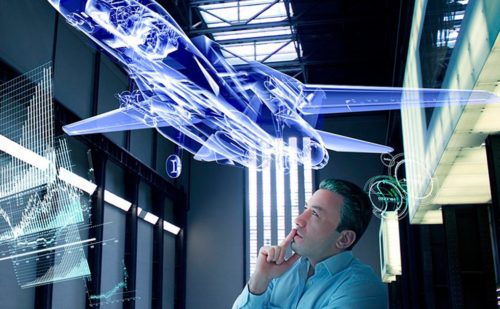Aeronautical and Aerospace Engineering

Content updated as of March 2025
In this article, we will attempt to summarize the most important aspects of Aeronautical Engineering. The information provided here should be complemented with the details offered by the universities themselves.
Index
- What is Aeronautical and Aerospace Engineering?
- Differences Between Aeronautical and Aerospace Engineering
- Brief History and Evolution
- Functions and Responsibilities of an Aeronautical Engineer
- Profile and Skills of an Aeronautical Engineer
- Aeronautical Studies in Spain (2025)
- Bachelor’s Degree in Aeronautical or Aerospace Engineering
- Master's or Postgraduate Studies in Aeronautical Engineering
- Entering the Job Market
- Postgraduate Studies in Airport and Aeronautical Management
- Where to Study Aeronautical or Aerospace Engineering?
- Aeronautical Engineer Career Prospects
- Frequently Asked Questions (FAQ)
- Specialized Training at ITAérea
What is Aeronautical and Aerospace Engineering?
Aeronautical engineering is one of the most demanding and exciting branches of engineering, dedicated to the design, development, manufacturing, maintenance, and operation of aircraft. This discipline ensures that everything that flies does so safely, efficiently, and sustainably, from commercial airplanes and helicopters to drones and new urban air mobility solutions.
Thanks to its constant evolution, aeronautical engineering has progressed from the Wright brothers’ prototypes to supersonic aircraft and hybrid and electric propulsion systems now being integrated into the industry by 2025. Its field of application includes both civil and military transport, logistics, general aviation, and the development of new technologies to improve the efficiency of the aviation sector.
Differences Between Aeronautical and Aerospace Engineering
The main difference lies in their field of operation:
- Aeronautical Engineering: Focuses on aircraft operating within Earth's atmosphere, including design, construction, and maintenance of airplanes, helicopters, drones, and other aerial vehicles.
- Aerospace Engineering: Also includes the design and development of crafts and devices operating outside the atmosphere, such as satellites, space probes, and rockets.
Both share a scientific and technical knowledge base, but their applications and career paths can vary significantly.
Brief History and Evolution
From the first flights in the early 20th century to today’s digital and sustainable revolution, aeronautical engineering milestones include:
- The development of mass commercial aviation.
- Introduction of the first commercial jets and supersonic aircraft.
- Creation of satellite navigation systems and advanced air traffic control.
- Integration of technologies such as artificial intelligence, big data, and 3D printing in aircraft manufacturing.
Learn more about the History of Aviation.
Functions and Responsibilities of an Aeronautical Engineer
| Area | Responsibilities |
|---|---|
| Design & Development | Creation of aircraft, components, propulsion systems, and structures |
| Maintenance | Managing inspections, reviews, preventive and corrective maintenance |
| Quality & Safety | Certification and compliance with EASA, ICAO regulations |
| Research & Innovation | Development of advanced materials, sustainable fuels, and new technologies |
| Regulation & Standards | Interpretation and application of national and international regulations |
Engineers also participate in air route planning, navigation system design, and innovative solutions like urban air mobility (UAM) and unmanned aerial vehicles (UAVs).
Profile and Skills of an Aeronautical Engineer
| Skills | Description |
|---|---|
| Technical Knowledge | Mastery of physics, mathematics, aerodynamics, and specialized software (CAD, CAM, CFD) |
| Teamwork | Coordination with multidisciplinary teams, suppliers, and official bodies |
| Adaptability | Constant updating to new technologies and regulations |
| Project Management | Planning, leading, and executing highly complex projects |
| Effective Communication | Drafting reports, technical presentations, and team management |
Aeronautical Studies in Spain (2025)
Bachelor’s Degree in Aeronautical or Aerospace Engineering
Duration: 4 years (240 ECTS) with solid training in:
- Aerodynamics
- Fluid Mechanics
- Aircraft Structures
- Propulsion Systems
- Electronics and Avionics
- Aeronautical Legislation and Standards
Top Universities:
- Universidad Politécnica de Madrid (UPM)
- Universidad de Sevilla (US)
- Universitat Politècnica de Catalunya (UPC)
- Universidad de León (ULE)
- Universidad de Vigo (UVigo)
Cut-off scores (2025):
Between 10 and 12 depending on the university.
Core Subjects
Mathematics and Physics are the most challenging subjects, ensuring students develop strong problem-solving skills. The program also covers thermodynamics, heat transfer, material resistance, fluid mechanics, aeroelasticity, propulsion, and flight control.
Master's or Postgraduate Studies in Aeronautical Engineering
Postgraduate education is essential to specialize and access senior technical or management positions. Examples include:
- Air Safety
- Advanced Aircraft Design
- Urban Air Mobility (UAM)
- Airport and Air Transport Management
Recommended Institutions:
Continuous education is key in this ever-evolving technological and regulatory sector.
Entering the Job Market
Employment Sectors:
- Airlines and air operators: Iberia, Vueling, Ryanair, Emirates.
- Aircraft manufacturers: Airbus, Boeing, Embraer.
- Drone and eVTOL industries: Lilium, Volocopter.
- Air Navigation Providers: ENAIRE
- Defense and Aerospace: ESA, NASA, Airbus Defence.
- Consulting and Official Agencies: AESA, EASA
Emerging Growth Areas (2025):
- UAM and autonomous aerial vehicles
- Electric and hybrid propulsion
- Artificial Intelligence and Big Data for predictive maintenance
- Air Cybersecurity
Salary Expectations:
| Location | Salary Range (Annual) |
|---|---|
| Spain | €30,000 - €50,000 (junior) / up to €80,000 (senior) |
| Europe | €50,000 - €90,000 |
| USA/Asia | €70,000 - €120,000 |
Salaries vary based on experience, specialization, and geography.
Differences Between Aeronautical and Aerospace Engineering
| Aspect | Aeronautical | Aerospace |
|---|---|---|
| Work Scope | Aircraft within Earth's atmosphere | Vehicles and systems within and beyond the atmosphere |
| Applications | Commercial, military aviation, UAM | Satellites, rockets, space missions |
| Main Employers | Airlines, aircraft manufacturers, airports | Space agencies (ESA, NASA) |
Advances and Trends in Aeronautical Engineering (2025)
Technological Innovations
- 3D Printing: Lighter, stronger parts
- New Composite Materials: Carbon fiber and hybrids
Sustainability
- Sustainable Aviation Fuels (SAF)
- Hybrid and Electric Propulsion
Digitalization and Automation
- Big Data and AI: Failure prediction, route optimization
- Autonomous Systems: Progress in drones and UAM
Regulations and Safety
Success Cases and Key Projects
- Airbus ZEROe: Hydrogen-powered commercial aircraft, launch expected by 2035
- Lilium Project: Development of electric air taxis
- ESA Programs: Satellites, space exploration, European aerospace technology
Postgraduate Studies in Airport and Aeronautical Management
Pursuing a specialized postgraduate program is a strategic decision for engineers aiming for technical or managerial roles.
Why Pursue a Postgraduate?
The aeronautical industry is highly competitive, with constant technological and regulatory changes. Advances in sustainability, digitalization, automation, and UAM create demand for highly qualified professionals.
Postgraduate programs allow specialization in:
- Aeronautical Safety and Risk Management
- Aircraft Structural and Aerodynamic Design
- Airport and Air Transport Management
- UAV and Drone Systems
- UAM and Electric eVTOL Vehicles
They also provide networking opportunities with top companies globally.
Key Benefits:
- Constant updates on international regulations (EASA, ICAO)
- Better salary prospects
- Leadership and project management skills
- Internationalization with English modules and global internships
Top Programs:
- Master in Operational Safety Management (SMS)
- Master in Sustainable Air Transport Management (MATSM)
- Master in Airport and Aeronautical Safety Management (MAAS)
- MBA in Aeronautical Management (MBAAM)
Where to Study Aeronautical or Aerospace Engineering?
Top universities in Spain:
- Universidad Politécnica de Madrid (UPM)
- Universitat Politècnica de Catalunya (UPC)
- Universidad de Sevilla (US)
- Universidad de León (ULE)
- Universidad de Vigo (UVigo)
- ITAérea Aeronautical Business School
Universities and Admission Cut-offs (2024-2025):
| University/School | Degree | Province | Mode | Cut-off Grade |
|---|---|---|---|---|
| UPM | Aerospace Engineering | Madrid | On-campus | 12.8 |
| UPC | Aerospace Engineering | Barcelona | On-campus | 11.6 |
| US | Aerospace Engineering | Seville | On-campus | 10.95 |
| ULE | Aerospace Engineering | León | On-campus | 10.5 |
| UVigo | Aerospace Engineering | Pontevedra | On-campus | 10.4 |
Note: Cut-off grades may change each academic year. Check with universities directly.
Study Abroad
Top international institutions include:
Online Aeronautical Engineering
Several schools offer flexible online programs combining theoretical learning with simulators and virtual labs.
Aeronautical Engineer Career Prospects
A rapidly growing field with strong global demand. In 2025, the outlook remains highly positive, with new opportunities emerging from sustainability and technology advancements.
Key Employment Areas:
- Aircraft and component manufacturers (Airbus, Boeing, Embraer, Bombardier)
- Airlines and airport operators (Iberia, Ryanair, Vueling, Emirates)
- Defense and aerospace (ESA, NASA)
- Drones and UAM companies (eVTOL development)
- Consulting and international agencies (EASA, ICAO, AESA)
Emerging niches include sustainable fuels, electrification, AI applications, and cybersecurity.
ITAérea Advantage:
With an international presence and close collaboration with industry leaders, ITAérea offers exclusive global job opportunities.
Frequently Asked Questions (FAQ)
What does an aeronautical engineer do? Designs, builds, and manages aircraft and aviation systems.
Where can I study in Spain? UPM, US, UPC, ULE, UVigo.
Salary? From €30,000 (junior) to €80,000+ (senior or international positions).
Difference with aerospace engineering? Aeronautical focuses on atmospheric flight; aerospace includes space.
Duration? 4 years for the bachelor’s plus 1-2 years of master’s.
Requirements? A bachelor’s degree and preferably a master’s specialization.
Cost? €800 to €2,500 per year at public universities.
Career paths? Airlines, manufacturers, consultancies, defense, UAM, drones, and space agencies.
Specialized Training at ITAérea
- MBA in Aeronautical Management (MBAAM)
- Master in Sustainable Air Transport Management (MATSM)
- Master in Airport and Aeronautical Safety Management (MAAS)
Contact us: info@itaerea.com


